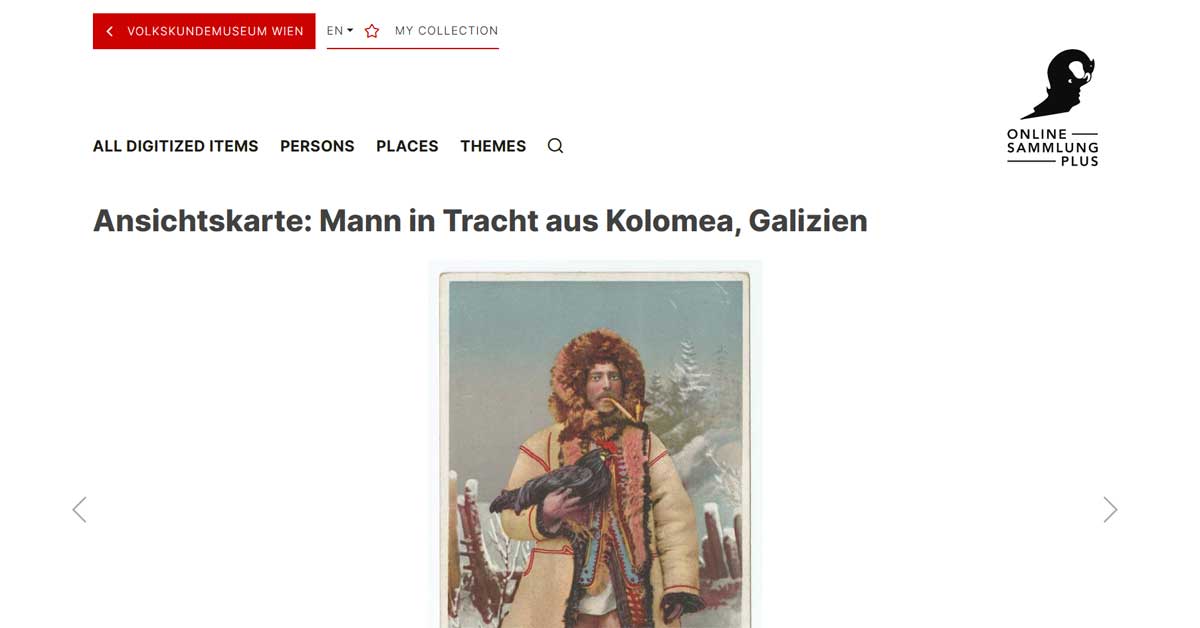

| 10 April 2025 Austria’s Public Museum Collections Go Digital: Access to Clothing and Textiles from Volkskundemuseum  Shared Cultural HeritagePaintings, sculptures, everyday objects, items of clothing, or tools from past centuries – these are not just exhibits in display cases or picture frames, but part of a shared cultural heritage. In Austria, many of these collections are owned by public museums, sponsored either by the republic, states, or cities. This means that these holdings do not belong to individual institutions or elites – they belong to the public, i.e., to all citizens of this country.This structure is a cornerstone of democratic cultural policy: Museums preserve and care for these items on behalf of the public – maintained through taxpayers’ contributions and made accessible in return. Anyone visiting an exhibition or viewing an object from a museum’s holdings is encountering a piece of their collective property. These are public treasures, open to everyone – not just a specialized audience. And now, with expanding digital access, exploring these collections can begin with just a few clicks from home. Funded by Citizens: Digital Heritage for AllThe broad initiative to digitize museum collections across Austria is funded through public money—taxpayer contributions allocated via national cultural strategies. One of the key programs enabling this work is "Kulturerbe digital" (Digital Cultural Heritage), launched by the Federal Ministry for Arts, Culture, Civil Service and Sport (BMKÖS). With funding from the European Union's NextGenerationEU recovery plan, the program supports the digital preservation, cataloging, and online presentation of cultural assets.Grants ranging from €30,000 to €300,000 are available per project, supporting a wide range of activities—from high-resolution imaging to creating searchable online databases. The goal is simple yet ambitious: to open Austria's cultural treasures to researchers, educators, students, and curious minds everywhere. Volkskundemuseum Wien – A Collection in TransitionOne of the institutions participating in this digital initiative is the Volkskundemuseum Wien, which received €299,626 through "Kulturerbe digital" to expand its Online Collection Plus—a public research and download platform accessible at sammlung.volkskundemuseum.at.The project is still in progress, with new materials continuously being added. The platform already features over 18,000 digitized objects, including photographs, archival documents, publications, and more than 100 3D-scanned items. Categories include ceramics, photography, graphic works, stone, glass, and others—offering new ways to explore everyday culture across time. Textile and Clothing Collection – A Rich Resource Coming SoonIn a phone interview with Fashion.at, the Volkskundemuseum shared that the first entries on objects from the Textile & Clothing section of its digital collection are slated to go online in early 2026. The update will include fascinating pieces such as:- 50 objects from designer Emilie Flöge - 160 embroidery samples - 50 belts - 70 "hair pictures"—small artworks made of human hair, created as memorials and often arranged in flower-like, naturalistic forms - Many of these items—especially the belts and Flöge's objects—will be available in 3D visualizations. A dedicated blog post about the 3D digitization process is already available on the museum's website. The curators of this department also run an Instagram channel, @textileclothingcoll.vkmvienna, where they regularly share selected themes and insights from one of the largest ethnographic textile collections in Europe. Topics range from historical garments and embroidery patterns to the social significance of everyday clothing. The format brings science, fashion history and everyday culture directly into the digital space - accessible, vivid and understandable. How to Use the 'Online Sammlung Plus'The platform is open to everyone—whether for school projects, academic research, artistic inspiration, or simple curiosity. A variety of search and filter tools help users navigate the collection based on interest, time period, material, or geographic region. You can create a personalized list of favorites for 'My Collection' and access full-text versions of the museum's historical publications, including journals dating back to 1895.First Steps into the Online Database: A Costume Album as GatewayTo help users get started, the site offers curated albums—thematic groupings of objects that provide both visual and contextual orientation. One standout example is the album "Franz Gaul and Josef Löwy – The Collectible Picture Series Austro-Hungarian National-Costumes (1881–1890)". This collection presents 72 illustrations of regional costumes from across the former Austro-Hungarian Monarchy, created by painter and costume expert Franz Gaul and photographer Josef Löwy. Originally marketed to affluent audiences in formats like leather-bound portfolios and rare Carte de Boudoir prints, these images became influential in shaping bourgeois costume culture, especially in Alpine regions like Tyrol and South Tyrol. The Volkskundemuseum Wien holds 145 related images, including drafts and duplicates—offering rare insight into the production process.This digital album not only makes it easier to explore historic costume depictions (Trachten) but also serves as a practical example for understanding how the broader database is structured and how different media types are interlinked. It's a great starting point for discovering Austria's cultural heritage. Culture Is Not a Closed Space: Digital Access for EveryoneThe digital cataloging of museum holdings is more than a technical project—it's a democratic offering. Those who click through the online collection discover not just objects, but partial histories of a shared cultural heritage. They reveal what people in Austria and beyond have created, worn, thought, or preserved. And they remind us that culture is not a closed space—but a living whole that belongs to all of us.Image: Screenshot of the Online Sammlung Plus page from the Volkskundemuseum Wien showing a historical postcard titled 'Man in Hutsul costume from Kolomea, Galicia (now Kolomyia, Ukraine).' The image is a hand-colored studio portrait from the 1880s, depicting a man in a winter coat with a fur hood holding a rooster. The postcard was created in the former crown land of Galicia, which was part of the Habsburg Empire from 1772 to 1918. After World War I, Galicia was divided and became part of present-day Ukraine and Poland. Source: sammlung.volkskundemuseum.at. |